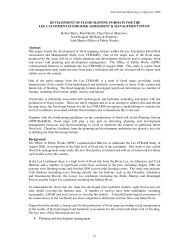Vegetation (Floating River Vegetation) - Office of Public Works
Vegetation (Floating River Vegetation) - Office of Public Works
Vegetation (Floating River Vegetation) - Office of Public Works
Create successful ePaper yourself
Turn your PDF publications into a flip-book with our unique Google optimized e-Paper software.
prevented aquatic growth.<br />
Water levels in the <strong>River</strong> Nore survey square were low and <strong>of</strong>ten absent for many <strong>of</strong> the<br />
smaller watercourses surveyed. In watercourses with water depth described as a trickle the fine sand<br />
or mud deposits <strong>of</strong> the river bed were too dry to support floating river vegetation. Deeper waters<br />
were dominated with larger pondweed species.<br />
<strong>Floating</strong> river vegetation was observed on the majority <strong>of</strong> the survey sites within the<br />
Mulkear <strong>River</strong> square. Stone, gravel and fine sand were the dominant channel substrate recorded.<br />
Shade and partial shade were noted for site 1 and site 8. <strong>Floating</strong> river vegetation was observed on<br />
all sites maintained by the <strong>Office</strong> <strong>of</strong> <strong>Public</strong> <strong>Works</strong> along with two channels not maintained by the<br />
<strong>Office</strong> <strong>of</strong> <strong>Public</strong> <strong>Works</strong>.<br />
Watercourses within the <strong>River</strong> Maigue survey square consisted <strong>of</strong> mud and fine sands and<br />
were <strong>of</strong>ten heavily colonised by aquatic vegetation including floating river vegetation. Of the<br />
watercourses surveyed over fifty percent were maintained by the <strong>Office</strong> <strong>of</strong> <strong>Public</strong> <strong>Works</strong> with site 2<br />
supporting floating river vegetation. Site 3 was the only site to experience shade. It did not support<br />
floating river vegetation.<br />
Not all <strong>of</strong> the watercourses maintained by the <strong>Office</strong> <strong>of</strong> <strong>Public</strong> <strong>Works</strong> supported floating<br />
river vegetation. Partial shade may be responsible for the absence <strong>of</strong> floating river vegetation at site<br />
8 while low water levels on the <strong>River</strong> Feale may also be a factor. Stone and peat base was the<br />
dominant substrate in the <strong>River</strong> Feale survey square supporting floating river vegetation.<br />
Only four watercourses survey in the Bandon <strong>River</strong> square supported floating river<br />
vegetation. Although partial shade was recorded for the remaining watercourses colonisation with<br />
dense aquatic vegetation and terrestrial plant species reduced the sunlight penetrating the water<br />
surface. The bed <strong>of</strong> the Bandon <strong>River</strong> at Dunmanway supported a sizeable population <strong>of</strong> floating<br />
river vegetation.<br />
3.6 Groenlandia densa on the back drains <strong>of</strong> the <strong>River</strong> Shannon<br />
Groenlandia densa (Opposite leaved pondweed) is a legally protected plant species<br />
classified as endangered and vulnerable in the Irish Red Data Book (Curtis & McGough, 1988).<br />
Originally recorded at thirty-two sites across the republic <strong>of</strong> Ireland, sites in recent times the<br />
number has decreased to a total <strong>of</strong> three sites in counties Limerick, Laois and Dublin. Groenlandia<br />
densa (G.densa) colonises deposited mud on the bottom <strong>of</strong> ditches, streams, ponds and canals. It<br />
has been suggested that the decline <strong>of</strong> the species in Ireland is due to land drainage and reclamation,<br />
pollution, peat run-<strong>of</strong>f and loss <strong>of</strong> habitat due to infilling <strong>of</strong> watercourses.<br />
According to the EUNIS website four candidate Special Areas <strong>of</strong> Conservation (cSAC) in<br />
Ireland have identified G. densa as part <strong>of</strong> their protected flora and these are tabulated below. Of<br />
27

















